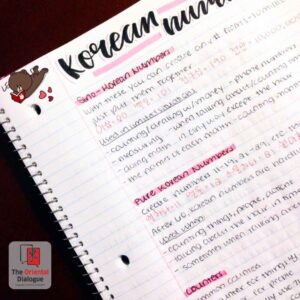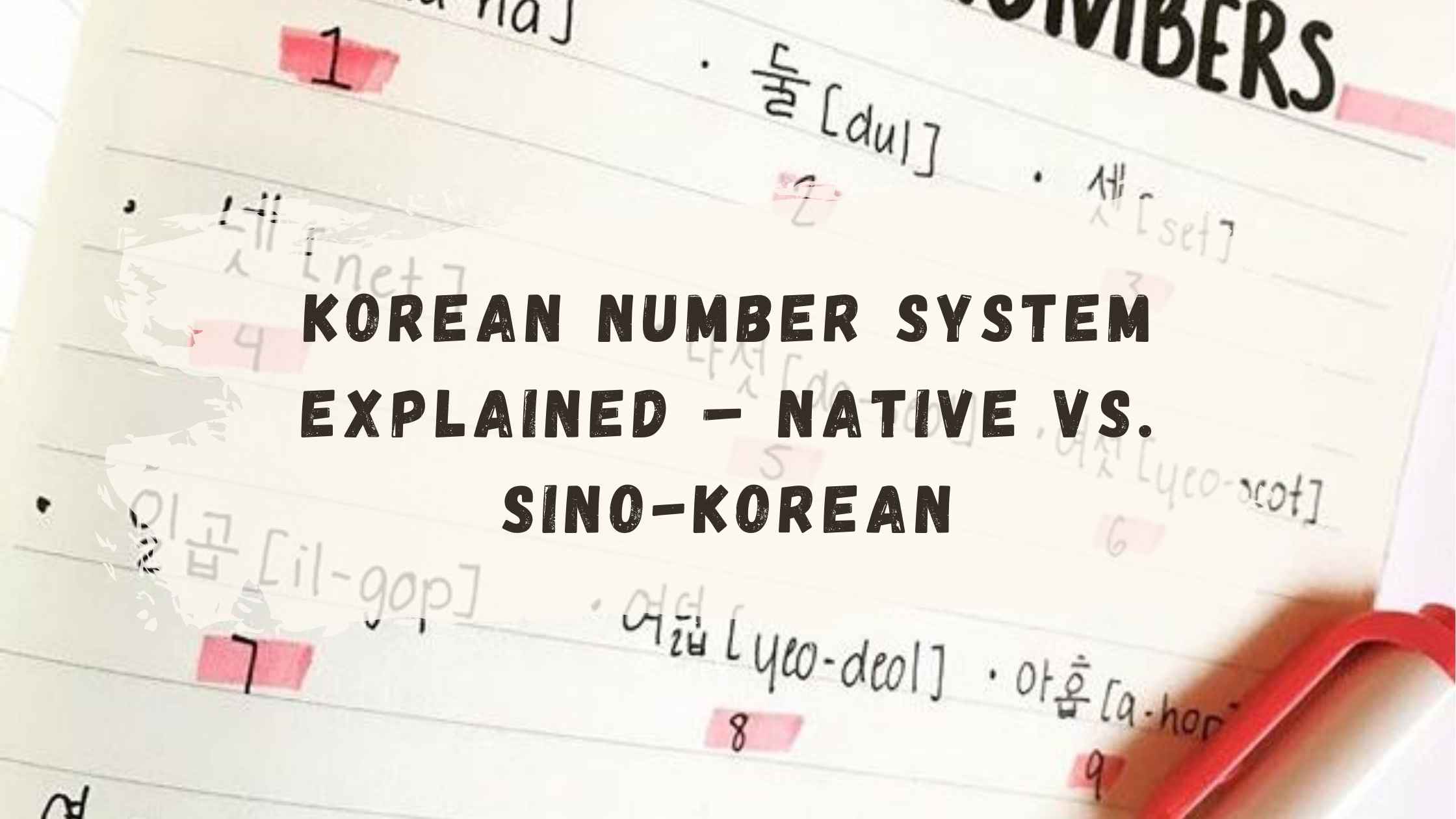What Are Sino-Korean and Native Korean Numbers?
 Sino-Korean Numbers (일, 이, 삼…)
Sino-Korean Numbers (일, 이, 삼…)
Sino-Korean numbers come from Chinese and are based on Chinese pronunciation. They are used in formal, mathematical, and official contexts.
Basic Sino-Korean Numbers:
| Number | Korean |
| 1 | 일 (il) |
| 2 | 이 (i) |
| 3 | 삼 (sam) |
| 4 | 사 (sa) |
| 5 | 오 (o) |
| 6 | 육 (yuk) |
| 7 | 칠 (chil) |
| 8 | 팔 (pal) |
| 9 | 구 (gu) |
| 10 | 십 (sip) |
Numbers above 10 are built logically:
- 11 = 십일 (10 + 1)
- 25 = 이십오 (2×10 + 5)
- 100 = 백 (baek)
- 1,000 = 천 (cheon)
Native Korean Numbers (하나, 둘, 셋…)
These are unique to Korea and are used more casually, especially when counting things or people.
Basic Native Korean Numbers:
| Number | Korean |
| 1 | 하나 (hana) |
| 2 | 둘 (dul) |
| 3 | 셋 (set) |
| 4 | 넷 (net) |
| 5 | 다섯 (daseot) |
| 6 | 여섯 (yeoseot) |
| 7 | 일곱 (ilgop) |
| 8 | 여덟 (yeodeol) |
| 9 | 아홉 (ahop) |
| 10 | 열 (yeol) |
Numbers above 10:
- 11 = 열하나 (10 + 1)
- 15 = 열다섯 (10 + 5)
- 20 = 스물 (seumul)
- 30 = 서른 (seoreun)
Note: Native numbers are mostly used up to 99.
 🧭 When Do You Use Each Number System?
🧭 When Do You Use Each Number System?
Here’s a helpful rule of thumb:
| Usage | Number System | Example |
| Age (informally, with 살) | Native Korean | 스물다섯 살 (25 years old) |
| Age (official docs, with 세) | Sino-Korean | 이십오 세 (25 years old) |
| Phone numbers, dates, money | Sino-Korean | 공일공-삼사오-육칠팔구 |
| Minutes, seconds, floors | Sino-Korean | 삼십 분 (30 minutes) |
| Hours (with 시) | Native Korean | 두 시 (2 o’clock) |
| Counting things (with counters) | Usually Native | 사과 다섯 개 (5 apples) |
| Counting people | Native Korean | 사람 세 명 (3 people) |
| School grade/years | Sino-Korean | 일학년 (1st grade) |
🧮 Two Number Systems, Two Roles
| Number System | Origin | Used For |
| Sino-Korean | Chinese | Dates, money, phone numbers, measurements, math, addresses |
| Native Korean | Indigenous | Counting objects, people, age (informally), hours (time), general counting |
Let’s look at each in more detail.
📘 Sino-Korean Numbers (일, 이, 삼…)
How They Work
These numbers are used much like numbers in English. They’re consistent, easy to build, and used in official or formal contexts.
Numbers:
- 1: 일 (il)
- 2: 이 (i)
- 3: 삼 (sam)
- …
- 10: 십 (sip)
- 100: 백 (baek)
- 1,000: 천 (cheon)
- 10,000: 만 (man)
Examples of Usage:
| Use Case | Example |
| Dates | 3월 1일 → 삼월 일일 (March 1st) |
| Phone numbers | 010-3456-7890 → 공일공-삼사오육-칠팔구공 |
| Money | 5,000원 → 오천 원 |
| Minutes/Seconds | 30 minutes → 삼십 분 |
| Floor numbers | 2nd floor → 이 층 |
| Math, percentages | 10% → 십 퍼센트 |
🌿 Native Korean Numbers (하나, 둘, 셋…)
How They Work
These are used when counting things or telling time (hours), and especially when you’re being casual or speaking naturally.
Numbers:
- 1: 하나 (hana)
- 2: 둘 (dul)
- 3: 셋 (set)
- 4: 넷 (net)
- 5: 다섯 (daseot)
- …
- 20: 스물 (seumul)
- 30: 서른 (seoreun)
- 40: 마흔 (maheun)
Note: After 99, Native Korean numbers are rarely used.
Examples of Usage:
| Use Case | Example |
| Age (casual) | 25 years old → 스물다섯 살 |
| Hours (time) | 2 o’clock → 두 시 |
| Counting people | 3 people → 세 명 |
| Counting things | 5 apples → 사과 다섯 개 |
| Counting animals | 2 dogs → 개 두 마리 |
⚠ Important:
When used before a counter (like 명, 개, 시), Native Korean numbers shorten slightly:
- 하나 → 한
- 둘 → 두
- 셋 → 세
- 넷 → 네
Example:
- 한 사람 (not 하나 사람)
- 세 시 (not 셋 시)
🧭 When to Use Which: A Quick Guide
| Situation | Use This System | Example |
| Age (spoken, casual) | Native Korean | 스물다섯 살 |
| Age (official, formal) | Sino-Korean | 이십오 세 |
| Telling time – Hours | Native Korean | 세 시 (3 o’clock) |
| Telling time – Minutes | Sino-Korean | 십오 분 (15 minutes) |
| Counting objects | Native Korean | 사과 다섯 개 (5 apples) |
| Counting people | Native Korean | 학생 두 명 (2 students) |
| Counting money | Sino-Korean | 오천 원 (₩5,000) |
| Math/percentages/room numbers | Sino-Korean | 이십 퍼센트 (20%) |
| Phone numbers/addresses | Sino-Korean | 공일공-팔팔팔팔 |
| Dates & calendar time | Sino-Korean | 십이월 이십오일 (Dec 25) |
| School grade/level | Sino-Korean | 일학년 (1st grade) |
💡 Pro Tips
- Start small: Focus on mastering 1–10 in both systems first. You’ll use them constantly.
- Listen to natives: Watch Korean shows and notice how numbers are used in real life.
- Practice with counters: Native Korean numbers usually appear with counting units like 개 (items), 명 (people), 시 (hours), etc.
- Make flashcards: One side with the number, the other with both systems + usage example.
✨ Final Thoughts
The two number systems in Korean may seem like a challenge at first, but they actually make the language more expressive and precise. With a little practice and context, you’ll naturally start using the right one without even thinking about it.
Next time you’re in a Korean market or telling someone your age, you’ll know exactly whether to say 스물다섯 or 이십오!




